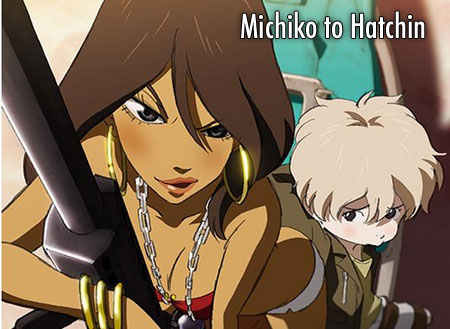Ask John: What’s John’s Opinion of Michiko to Hatchin?

Question:
What is your opinion of Michiko e Hatchin?
Answer:
Before diving into discussion of the Michiko to Hatchin anime series itself, I’d first like to address the intelligent bilingual wordplay in effect within the series’ title, since I haven’t seen any analysis of it before. The series’ title is spelled in Japanese with the names “Michiko” and “Hatchin” spelled in katakana, joined by the hiragana character “tō.” The title literally translates as “Michiko & Hatchin.” However, the official Romanization seen in the opening animation and certain eyecatch sequences is “Michiko e Hatchin” which, in Japanese, means “Michiko to Hatchin,” as in “Michiko toward Hatchin” or “Michiko gives herself to Hatchin.” In effect, the meaning of the Romanji (English language) title matches the pronunciation of the Japanese langauge title. I wish that the body of the show was as witty as the witty pun in the title.
Especially knowledgable and critical anime fans will understand the characteristics of the Michiko to Hatchin television series immediately when I refer to it as a typical Manglobe television production. Michiko to Hatchin is anime production studio Kabushiki Gaisha Manglobe’s third original television series, following Samurai Champloo and Ergo Proxy. Like both Samurai Champloo and Ergo Proxy, Michiko to Hatchin has an abundance of kinetic style and praiseworthy production values including attractive character design, expressive background art, fluid animation, and an evocative soundtrack. However, like previous Manglobe TV productions, it also suffers from inadequate character development and a disjointed pacing. Throughout at least its first half-dozen episodes, the show has epitomized the “style over substance” criticism in the worst way.
The accusation of “style over substance” isn’t inherently negative. Anime is fundimentally a visual art, so the refusal to acknowledge the significance of pure aesthetics in anime is a rejection of the basic substance of anime. Productions including Mao Lamdo’s “Cloud” sequence from Robot Carnival, the Angel’s Egg motion picture, the Fujin Monogatari television series, and the To-y, Nineteen, and B.B. Fish OVAs are all lovely examples of effective and memorable cinematic style with minimal substance. Anime is perfectly respectable and successful as atmospheric visual art when that’s all that it’s trying to be. However, Michiko to Hatchin feels very much like it wants to be a feminine version of Cowboy Bebop. I’ve long criticized Cowboy Bebop for not including enough revelation of character psyche, but even Cowboy Bebop reveals much more about its characters’ thoughts and motivations than Michiko to Hatchin has, so far.
The first six episodes of Michiko to Hatchin have included numerous flashbacks, but none of them have substantially contributed to viewers’ understanding of Michiko’s psychology. The series clearly wants viewers to sympathize with certain characters at certain times, but genuine empathy is difficult to extend because viewers haven’t been given much reason to care about the characters. Hana has been abused, but she never feels sorry for herself and doesn’t seek sympathy. Michiko is supposed to be periodically sympathetic, but viewers haven’t been allowed into her head, so we don’t know what she’s thinking and have little reason to sympathize for her. Her actions, and the flashbacks to her past, reveal only that Michiko is a loudmouth who’s frequently unable to back up her bravado. Liliana frequently demands trust, but demonstrates no reason to deserve any trust. Pepe complains about the people that disrespected her in her past, but her flashback provides no evidence of such persecution. Furthermore, Pepe’s sacrifice seems wasted since the show never establishes that it was necessary, and doesn’t illustrate its impact. I’m also frustrated by the series’ tendency to introduce characters like Atsuko, Pepe, and Lulu then discard them as mere extended cameo characters. If these supporting characters shared a common fate, the argument could be made that they all illustrate a common theme. But since they don’t, these characters just make the series’ narrative development feel unfocused.
In the case of any work of fiction, individual viewers can interpret their own meanings, themes, and relationships from the art presented on screen. I’m aware that Michiko to Hatchin has some strong supporters among its English speaking audience, but this is my own perspective on the show. I don’t demand that everything be literally and simplistically laid out, but so far I’ve seen six episodes of Michiko to Hatchin that want viewers to believe that the episodes are complex and profound when the series is actually just pretentious. I don’t think that Michiko to Hatchin is especially bad. It’s strengths are respectable, but they’re weighted down by the show’s lack of revealing psychological insight. Samurai Champloo and Ergo Proxy both attained moderate, temporal success because of their dynamic cinematic style, but failed to achieve the the lasting reputation of Cowboy Bebop because they’re shows that rely on superficial, shallow, chiche character archetypes in place of creating complex, psychological characters that viewers really care about. So far, I see Michiko to Hatchin developing exactly the same way.
Add a Comment
You must be logged in to post a comment.


>“Michiko e Hatchin†which, in Japanese, means “Michiko to Hatchin,â€
I think the ‘e’ in the Roman title means ‘&’ in Portuguese.